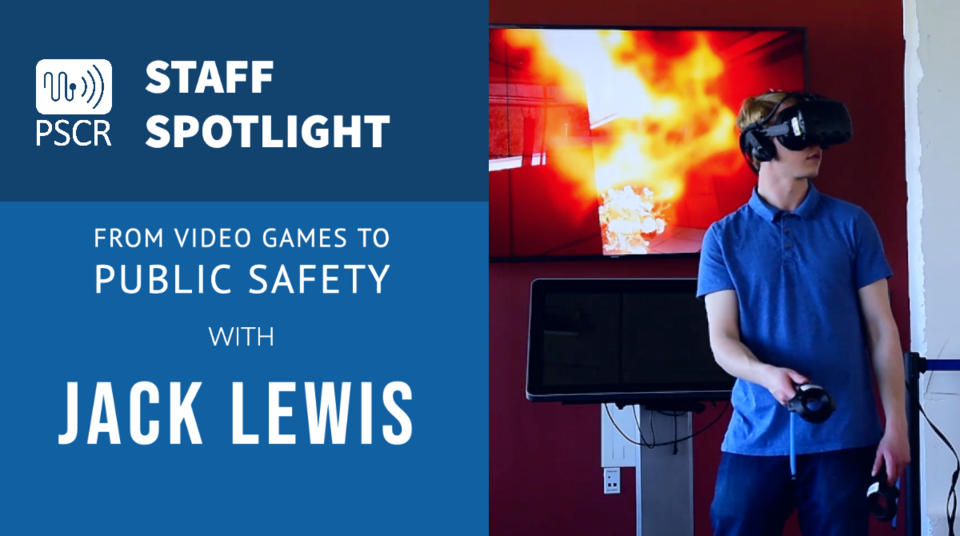
Jack Lewis is the Lead Virtual Reality (VR) developer at NIST's Public Safety Communications Research (PSCR) division. At PSCR, Lewis oversees the development of VR simulations for public safety and applies his passion for game design to PSCR's mission-driven work on a daily basis. His fresh perspectives and experience in gaming bring invaluable insight and know-how to the PSCR team.
PSCR's communications team interviewed Lewis to learn more about his unique gaming background and his upcoming role in the Building Virtual Reality for Public Safety Panel at PSCR 2020: The Digital Experience.
Can you describe your current role?
JL: I am the Lead Virtual Reality (VR) developer for PSCR, and my role is leading the team in the production of VR simulations that we can use for testing and training for public safety.
How did you end up in this role? Can you describe what compelled you to get involved in this type of work?
JL: Funny enough, I got into the role by accident. I saw a listing for a "VR Job in Boulder" and it didn't have any information about the division or public safety - but I applied anyway. About a week later, PSCR contacted me, and I landed an interview with PSCR's Division Chief, Dereck Orr. He not only showed me the project at its beginning, but he also talked about the future of the project and how it would help public safety and firefighters down the line. I was excited to hop on board because it was a different experience than the gaming industry that I had been in.
I was compelled to get involved because I knew the project would be very rewarding. I would get the opportunity to develop VR scenarios and move the public safety industry forward.
Can you describe your academic background and how your video game design experience fits into your role with PSCR?
JL: My academic background is in the games industry. I went to the Art Institute of Colorado where I received my Bachelor's degree in Game Art and Design, which focused on topics like game engines and modeling tools to build video games. VR actually uses those same tools to create the models, texturing, etc. Everything I learned about in college to create video games applies directly to VR. VR came into the foreground right as I was graduating, so I was on the first wave in this technology which has been pretty exciting.
What is your favorite part of your job? What has been your favorite project to work on?
JL: My favorite part of the job is how open leadership is to letting us experiment and try new things. If our team wants to try building something a certain way or try a new tool, they're supportive of it.
My favorite project that I've worked on is our SWAT Scenario. It's an active shooter scenario that we use to test user interfaces; we used it for a prize challenge that tested haptic interfaces. The main goal was to simulate the scenario of a SWAT member and an active shooter in a parking garage. We wanted to make a user interface that could allow first responders to train in a threat scenario while keeping the situation safe. We were able to integrate many concepts from video games that we used to build into VR and use the same techniques for various public safety applications.
What excites you about virtual and augmented reality technologies for public safety?
JL: The thing that excites me is how many avenues this technology can fill in public safety. First, we can use it for testing new technologies - we can use VR to test something digitally rather than building a physical prototype, which can be expensive to develop. With VR, we can simulate different training scenarios and test different technologies with public safety members before they even get to a physical phase of testing.
Then, AR is very applicable out in the field - I can see AR being used to overlay maps of a building or any number of real-world applications that would help speed up processes for public safety and effectively help save people.
Can you describe the panel you're involved in for PSCR 2020?
JL: I'm on a panel with two other members of the team (Chris Johnson and Jeff Karhoff), and we're using the panel to show how we go about building VR for public safety including the processes and tools we use. The main goal is to show people how we start the project, what tools we use throughout the project, and how our method influences the end product. We're going to cover examples like building realistic smoke simulations, building an AI firefighter that walks around with you, building 3D models, and more.
Why should people listen to your presentation?
JL: I think people should come to our session because it gives great insight into how we build these tools. It's not very common knowledge or practice - we're constantly getting questions whenever we're giving demos on what tools we use or how long it takes to make something. So, this presentation will be really insightful for anyone who wants to learn about VR or is curious about the processes and methods behind this technology for public safety.

